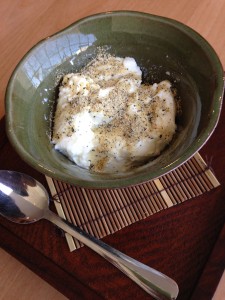Kimukatsu fails to deliver good flavor
As Asian comfort food goes, it’s hard to find an entree friendlier to American palates than tonkatsu. It’s a panko-breaded pork cutlet that’s deep-fried and served with a tangy, Worcestershire-like sauce. The dish was invented by the Japanese sometime in the early 19th century, and has become popular in both Japan and Korea.

Panna notta · Kimukatsu’s panna cotta doesn’t actually taste like the beloved Italian dessert, and its texture is reminiscent of paste. – Euno Lee | Daily Trojan
Enter Kimukatsu, a Japanese chain of tonkatsu restaurants which recently moved into spacious digs in Culver City’s new Culver Crossroads retail center off Sepulveda Boulevard. What sets Kimukatsu’s tonkatsu apart from the layperson’s katsu is the method of preparation: Instead of a single breaded cutlet, Kimukatsu breads 25 layers of thinly sliced pork which have been folded together, breaded and slowly fried to seal in the juices. The restaurant claims that this process creates a more tender, juicier katsu. The concept sounds strange, but like raw tuna belly and deep-fried octopus balls, intrigue in Japanese cuisine tends to lend itself to pleasant results. Usually.
The first thing to notice before walking in through the glass doors of Kimukatsu is the large “Intent to Serve Alcoholic Beverages” notice posted conspicuously next to the door. It’s a sign — pardon the pun — that the restaurant doesn’t have all its affairs in order just yet.
Upon walking in, it becomes more evident that Kimukatsu is nowhere near ready for the clientele it’s anticipating. A massive oak bar imposes on a third of the restaurant’s space. Small, intimate booths line the walls and a handful of tables with tacky, mismatched steel chairs fill out the cramped center. Condiments are not uniformly distributed; a few tables are missing the ponzu vinaigrette, others the all-important tonkatsu sauce. There’s a distinction to be made between tasteful minimalism and simple carelessness. As first impressions go, Kimukatsu is already firmly entrenched in the latter category.
Like the restaurant’s ambiance, the menu is simple. Diners can choose from a handful of different katsu fillings (including cheese), toppings such as curry or mushrooms and a vast array of dipping sauces — none of which look appetizing enough to splurge the extra dollar for. Which leads to the next point: Kimukatsu’s entrees are rather expensive for what they are. A dinner portion of six ounces of katsu starts at $22; a lunch special portion of four ounces is $13.
The trend of dressing up working class dishes is not a foreign (or unpleasant) concept to anyone who’s had a hamburger from David Myers’ Comme Ca or thyme-dusted French fries with tarragon remoulade at 25 Degrees. But at $22 for a measly six ounces, a katsu should offer something special. Unfortunately for Kimukatsu’s tonkatsu, unless “something special” is “three days of agonizing food poisoning for a certain Daily Trojan editor,” it doesn’t.
The idea of making a tonkatsu “juicy” sounds a little counterintuitive at first — after all, a deep-fried, panko-crusted pork chop isn’t a medium-rare filet mignon. There are expectations of how certain foods should taste and feel, and to errantly thrust notions of textures that might be valid for one dish onto another is haphazard at best, a gimmicky atrocity at worst.
An extremely juicy tonkatsu doesn’t work for the single reason that a large part of the dish’s selling point is a substantive crunch. One bite into Kimukatsu’s tonkatsu and it’s clear they’ve completely lost sight of what makes good katsu. Though the top shines golden brown, moisture soaks up the bottom layer into an oily, mealy paste. The pork lacks substance — instead, the allegedly tender meat flakes away like bad tilapia.
The shift in texture is also present in the most basic part of the meal: the rice. Though the top of the bowl shines with lustrous, firm grains, the watery clump of inedible rice underneath exposes the cook’s amateurish execution. The accompanying miso soup is also overwhelmingly salty and poorly balanced. Kimukatsu does deserve some credit — to fail this much in properly preparing the most basic Japanese food staples takes some serious effort. To open what looks to be an incredibly expensive restaurant to serve food this bad takes a special kind of audacity.
Dessert only makes the ongoing texture nightmare a disturbing reality. The panna cotta (which, it should be noted, came highly recommended by a server) looks like a clump of ricotta cheese, and the texture and flavor was reminiscent of an incredibly stubborn tapioca pudding. The staff here has either never tried actual panna cotta or hates their customers. Or both.
So for all of the hype and hoopla about a “juicy” tonkatsu being served deep in Bruin territory, Kimukatsu utterly fails to understand what makes a good tonkatsu in the first place. The restaurant paid extremely close attention to a worthless detail and failed to address the big picture just about everywhere else. It’s a flashy concept engineered toward a growing generation of pretentious food elitists.
Kimukatsu would do well to focus on the foundations of what makes good, edible comfort food in an effort to crawl back up to mediocrity. Instead, the restaurant has plans to open another location in Westwood. Which is, if you think about it, just too perfect.
Follow Euno on Twitter @eunowhat
